The beach south of Mangawhai was no less empty, peaceful and sun-washed than when I’d left it.
Five months had gone by since I last did a three-week stint on the 3000-kilometre, length-of-NZ Te Araroa trail. I’m doing the trail consecutively, north to south, at about 500 kilometres a year.
It was January, 2018, and I had another few weeks off. I drove up from Wellington to the point I’d got to last time, Pacific Rd, Mangawhai Heads, just north of Auckland.
Day 27 – Pacific Rd, Mangawhai to Pakiri beach: 16 kms.
I knocked on a farmhouse door near the road-end. Could I park beside their driveway, for security? I explained what I was up to, and that I’d be back in a few days to pick up my car. Sure, they said.
I pushed on down the beach. All morning, Taranga Island, part of the Hen and Chickens group, kept me company.
I was quickly into the free-associative state walking procures for me.
Taranga, I thought, with its twin summits at the northern end, was like a resting dog lying on the horizon, his ears pricked. Or like a waiting crocodile, wth her huge hooded eyes, and her corrugated spine.
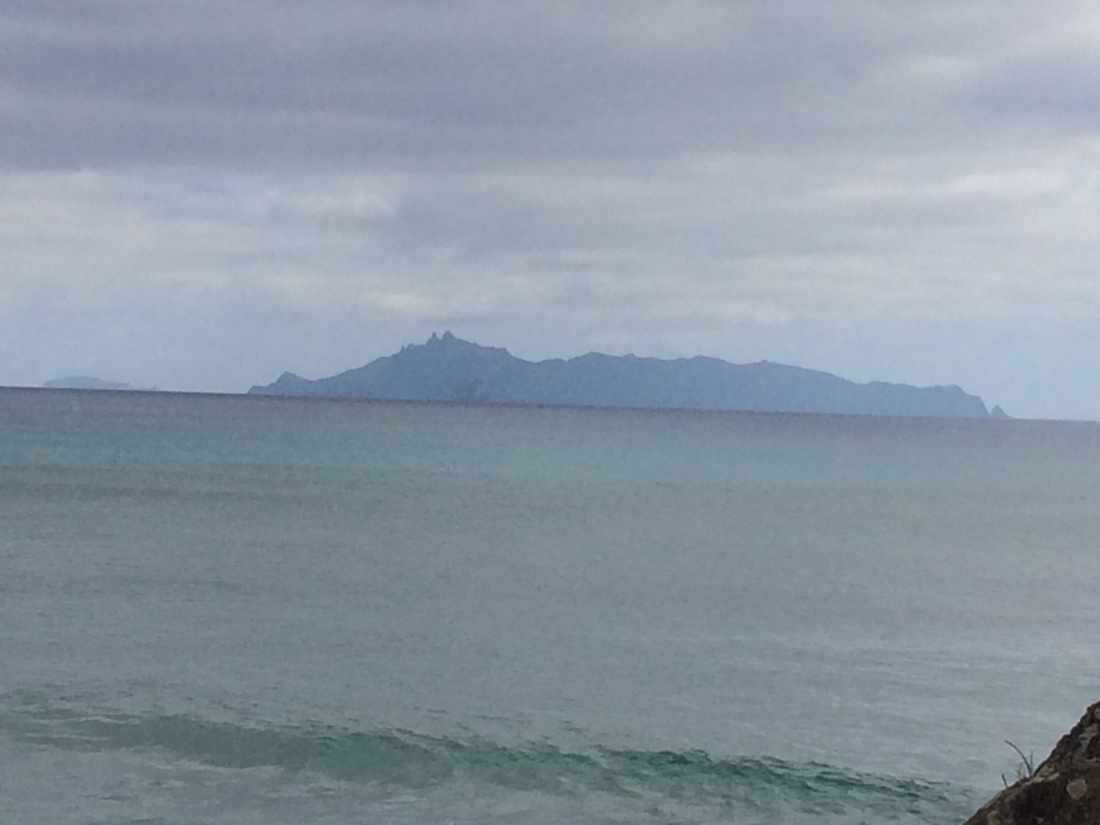
At Te Arai Point, I looked down on a school of surfers; and beyond them a cloud of little fish swaying in unison in the gentle washing of a clear bay.
The January sun beat down a lot more forcefully than it had in July. There was nowhere to hide on the long beach, no trees in sight. But right on schedule, when I was ready for lunch, a shelter appeared, rigged up by someone out of seaweed and driftwood.
I boiled the billy, ate tuna on crackers, went for a swim. It was good to be on the trail again.
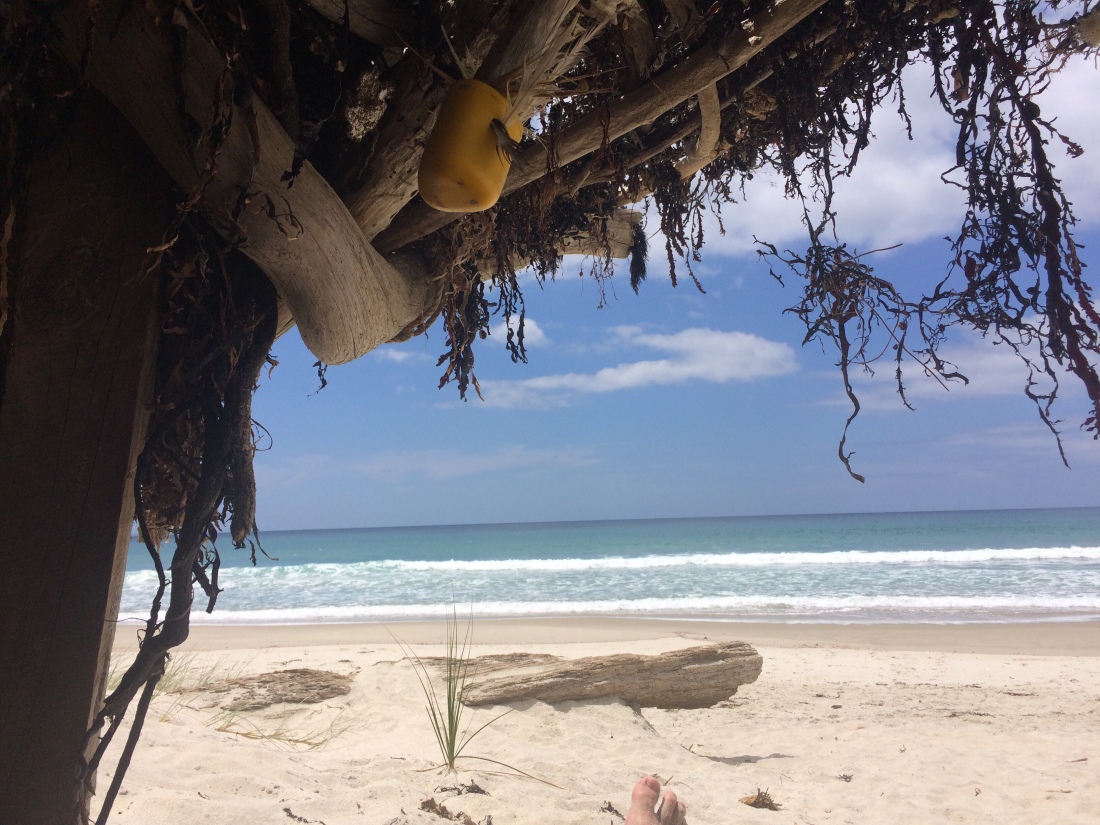
In the afternoon I pitched my tent at the Pakiri campground, where kids roamed in happy mobs and parents drank wine, listened to the cricket and flipped chops on communal barbies.
Day 28 – Pakiri to Waiwhiu Valley: 18km.
This turned out to be the hottest day of the year in many parts of the country; Otago recorded NZ’s hottest temperature in seven years.
While the heat built up, I was struggling up this bloody hill:
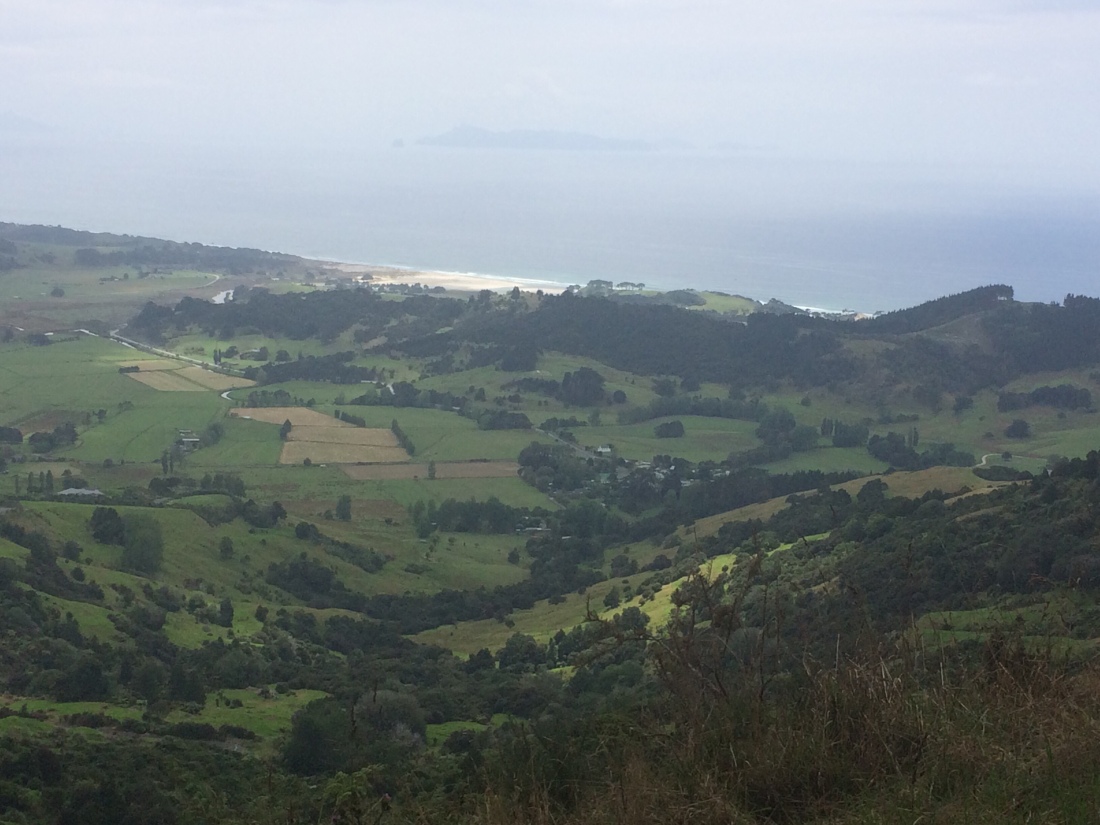
It’s a steep climb from sea level up through paddocks to Mt Tamahunga (437m), the highest point between Whangarei and Auckland.
The sweat was pouring off me, and I felt as if all the water I could drink evaporated as soon as I swallowed it.
But I was inspired to new heights of stoicism by a sign saying this track, Te Hikoi o te Kiri, was opened by none other than Sir Edmund Hillary.
Also inspiring is that the track got its name, Te Kiri’s March, in honour of an act of bold defiance against bloody British imperialism. Te Kiri, according to NZ Geographic, was a Ngāti Wai war chief who, in 1864, gave refuge in this forest to 180 dispossessed Waikato warriors he had freed from the governor’s prison.
The prisoners had been exiled on Governor George Grey’s estate at nearby Kawau Island, after British forces smashed their home at Rangiriri, north of Hamilton, with gunboats moored in the Waikato River.
(A couple of weeks later, on this same stint of Te Araroa, I would find myself on that very spot, Rangiriri, where the government shells rained down.)
I carried on into Omaha Forest, where there were views over posh Omaha Beach and out to Governor Grey’s private prison:

The track leads you out onto Matakana Valley Road. I had finished all my water and passed no streams, and was numb with thirst in that ruthless heat. I knocked on a door and drank deep.
A short road section took me onto a four-wheel-drive track, then, as the long summer twilight deepened, into DOC’s Totara Scenic Reserve.
A few kilometres in I set up camp by the thin, clear Waiwhiu Stream. Thick, old trunks rose all around, blocking out most of the stars. I felt the heavy, primitive cloak of the deep bush.
Before I went to bed, I washed in the stream under torchlight; a native fish hung in the current next to me.
Day 29 – Waiwhiu Stream to Ahuroa Rd near Moir’s Hill: 26km.
The morning saw me slogging away from the shadowy bush along Waiwhiu Stream up a steep forestry road into the Dome Forest. Pine soon gives way to thick, mature native bush; and the steep climb to a long, undulating route along a ridge.
It’s less than 500 metres high, this ridge, but it’s a seriously rugged little tramp: there’s plenty of mud, knotty rooty tangles, scrambles, slides, ups and downs to keep you conscious of your general puniness.
In the distance the top of the Dome emerges: it looks benign, but it will make you sweat and struggle.
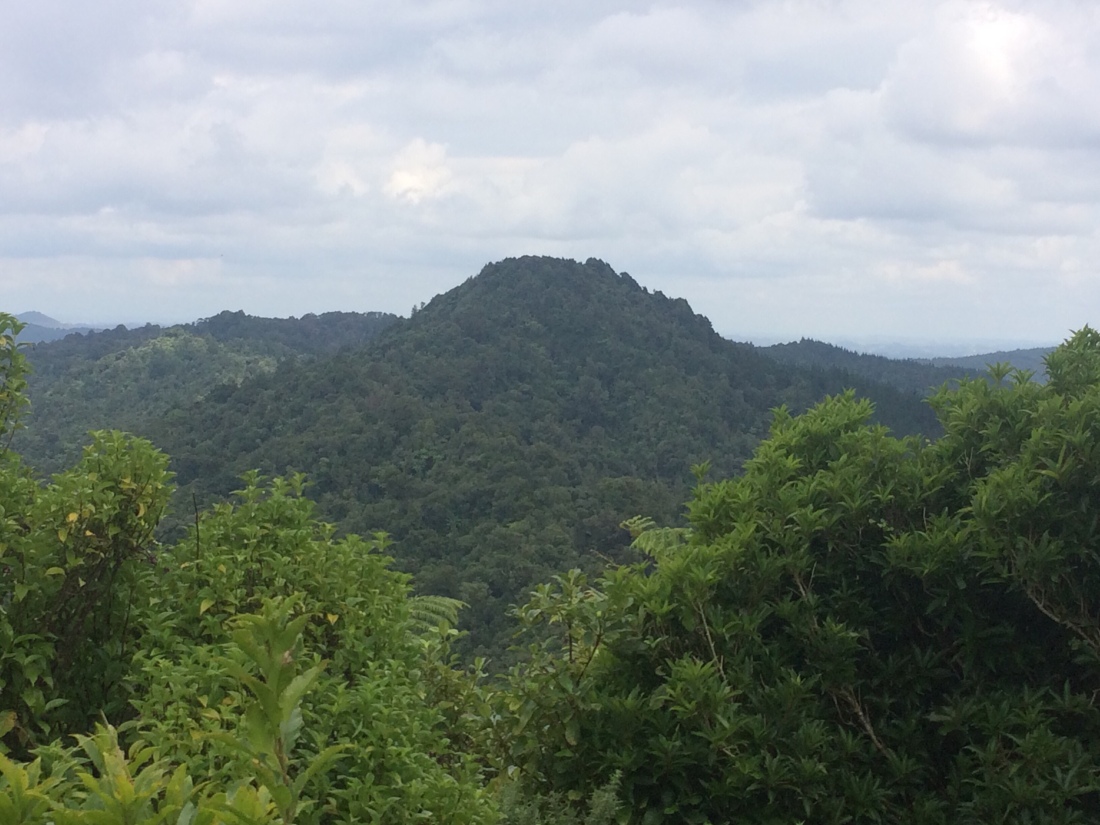
Finally you start to hear the boom and bleat of State Highway 1, and you reach a look-out – straight down the Dome Valley to Warkworth.
One of the coolest things about Te Araroa is the way it takes you in roughly the same direction as State Highway 1 – north to south – but elegantly keeps you away from it, apart from the occasional birds-eye glimpse:
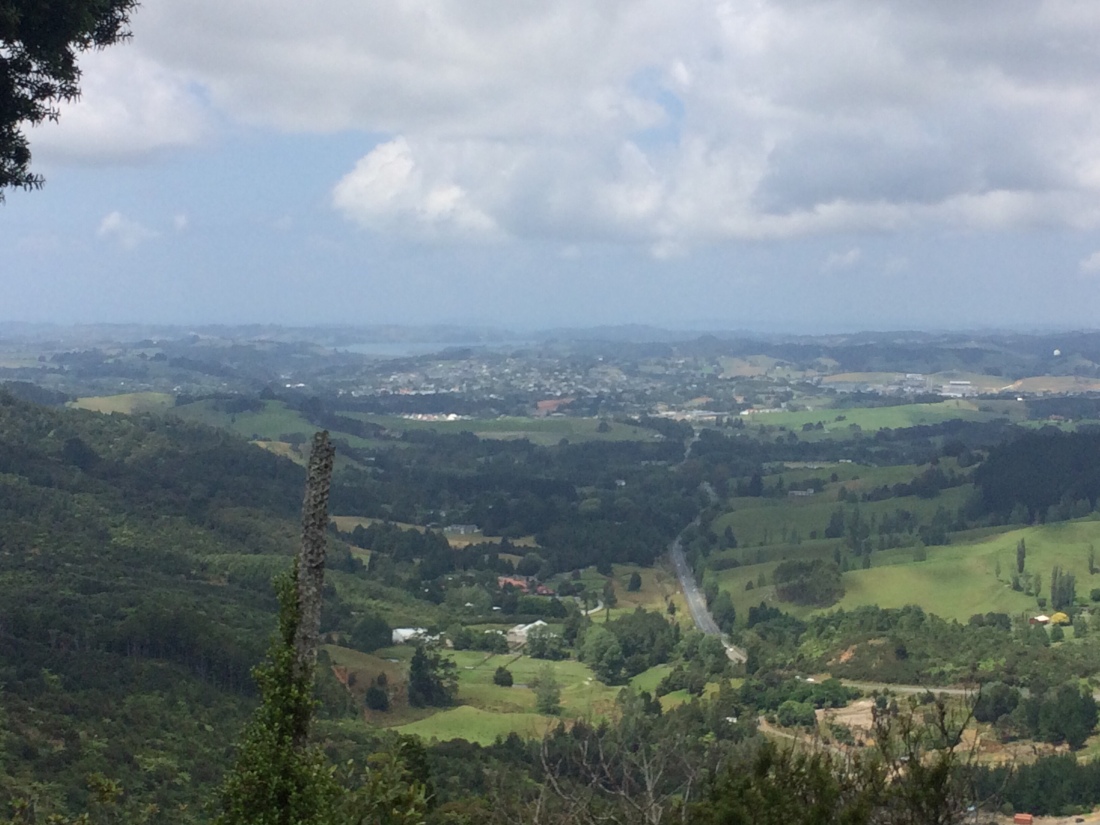
In this way you get to visit all the little back-waters and communities known only to themselves, their century-old war memorial halls and tiny schools, their secret vistas.
Booming on wheels along the highway, on the other hand, you get a sanitised view of New Zealand – it’s like a long, concrete canyon whose prescribed stops and starts are petrol stations, malls and chain stores, the exits and on-ramps amply and soberly signposted, lit up in LEDs and strobing arrows.
Everything about it is designed for ease and speed. The hills are levelled or punctured, there are heavily engineered tunnels, tolls, viaducts, enormous sweeping bends linking artificially long straights, straights that warp time, tame terrain, crush the land.
It makes me think of my sister’s affectionate joke about my Dad’s way of sitting for a minute or two after the car has pulled up, even after everyone else has got out, unpacked, gone in. “What’s Dad doing?” someone says. “He’s waiting for his soul to catch up with his body,” she replies. Who can blame him, with these spirit-warping roads?
Te Araroa, instead, sends you through all the bumpy, lumpy, rough, slow, knotty bits of New Zealand, the ones the roading technocrats bend over backwards to avoid, or steamroll.
Sometimes you’re in one of these funny, muddy, quirky little valleys, or on top of one of these forgotten hilltops, and you catch a whiff of bitumen or the far-off whoop and wail of tyres on rumble strips; and you feel like you’re in a parallel country, running roughly alongside the other one, the echoing one, the long, narrow concrete one.
The Dome Cafe is at a junction of these two countries, and is the perfect lunch stop – a lush salad, a strong coffee, and my soaked socks stiffening on the verandah rail.
The trail takes you straight past the cafe and across the highway. It’s just a lane in each direction at this point, but you still feel a bit vulnerable scuttling across between the stock trucks.
Then it’s a long, hot schlepp up gravel roads and into a back-country patchwork of bush, plantations and farms for the rest of the afternoon and evening.
The trail cunningly links up a few gravel roads that almost connect, by sending you across paddocks with those ubiquitous styles over fences.
It’s real heartland stuff, a nice contrast to the thick, wild bush of the morning and yesterday.
I’m sure parts of the South Island are more spectacular. But there are certain types of things you can really only see, and encounters you can really only have, in the rural heartland parts of Te Araroa.
For example, from one of these anonymous roads somewhere out the back of Warkworth I saw, in a paddock below, a beat-up four-wheel-drive hooning around a paddock, towing some sort of sleigh-like contraption behind it. There was a person aboard, laughing and screaming as the improvised sled swung in huge arcs behind the revving ute, sending up a wake of torn grass and mud; it was just like one of those sea biscuits people tow around at the beach, only in a paddock.
And later, from a rise in one of the paddock shortcuts I saw, far below in another paddock, a shiny, late-model car doing elaborate skids and other stunt manoeuvres; hand-brakies, reverse doughnuts.
I carried on down the hill and, back on a road, went into the first house I came to for water – the big ridge on the horizon in the picture below was coming up, and I knew there would be no water up there.
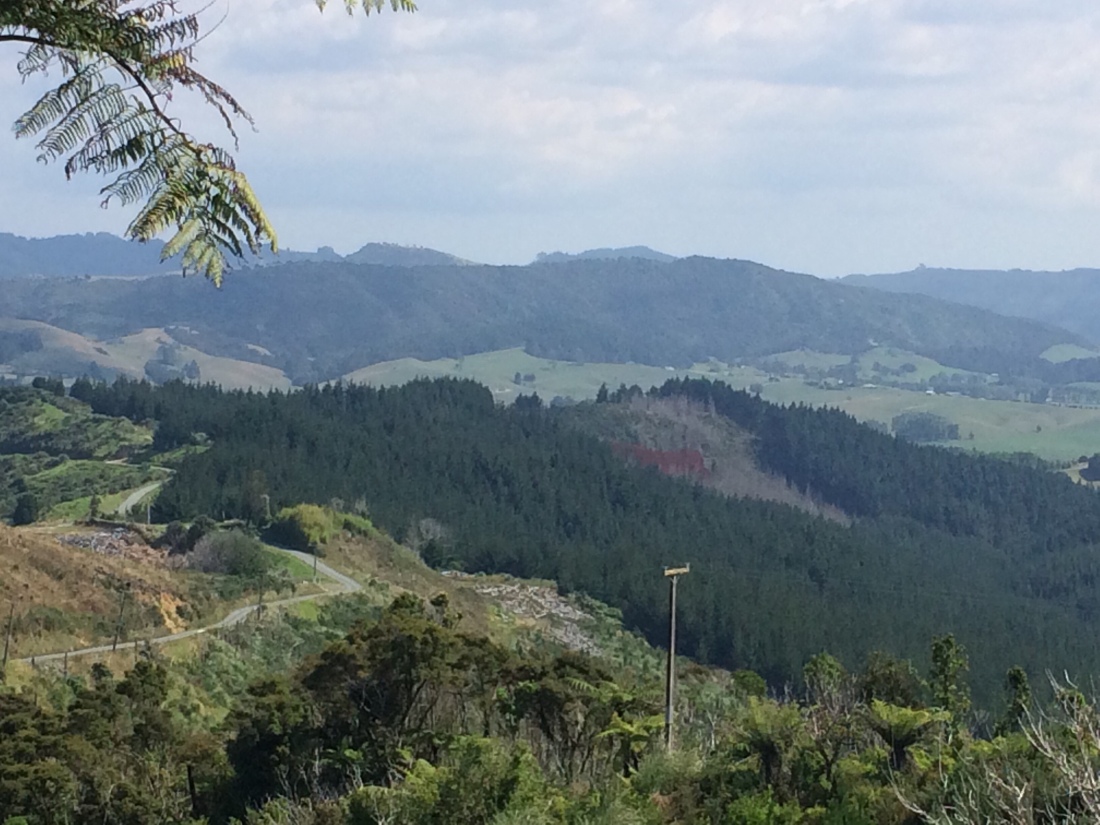
It was a well-kept, expensive looking place, with a hint of holiday home and a hint of farmhouse. Just as I went into the driveway the same car I’d seen in the paddock roared through the gate and skidded to a stop, with a lean, grinning blonde girl hanging out the front passenger-seat window.
Smiling, well-dressed people milled around; I explained what I needed, they invited me in to fill my Camel-Bak. There were chips and dips and grapes on plates covering a table. “Want a beer?”
I declined; I had a long way to go.
They were all curious about how I’d popped up, covered in sweat and dust, there, of all places, in their parallel Aotearoa; and they fired questions as I held the plastic bladder under the kitchen tap.
I was curious about them, too: there was a tight-wound intensity to their cheerfulness. Someone explained that they were mostly cousins; they’d grown up around here, had gathered at the farm for an elder’s milestone birthday party that night; they’d hired cars to come from the four winds; they were were mostly three sheets to those same winds.
“And what do you do when you get an awesome hire car?” one asked me, as if the answer was obvious. “You tear up a paddock.”
I was enjoying the genial chat and realising how badly I smelled, not having showered in a few days, just as the lovely blonde girl wandered into the kitchen. “Did I hear you say you were walking to Bluff?” she said. “That’s fuckin’ fantastic. Why are you doing that? Is it for a charity?”
No, I said – just for the hell of it. She stared at me thoughtfully and took this in for a moment, along with a pull on her beer, and hopefully not too much of my billy goat-like scent. Then: “You should do it for something!” she said with conviction. “Charity it up, man!”
Soon after, I left the monied farming families, dusty roads and lush farms behind and headed up Moir’s Hill. It’s steep, covered in pines, and has a radio tower at the top. About halfway up the forestry track improves, becomes a graded road to rough sections flattened into the harvested pines. Some developer obviously hopes to sell off these sweet views:

Sooner than I was ready, the sun began to set, silvering the toetoe leaves. I found my way past the radio tower and down a rough four-wheel drive track carved between pines on one side and scrub on the other. Thick gorse occasionally intruded. Before I’d got far it was fully dark; I lashed on my head torch and carried on.

I was making for Ahuroa Rd, where I planned to camp on or near the verge. When I was nearly there I got complacent, turned off my torch a while and bowled along in the moonlight, which was magical. But I soon ran into one of the big pitfalls of moonlit tramping: losing your way.
A half-hour, muddy, exhausting bushbash followed; I’d somehow missed a short, steep track down to the road. Instead, I had to pick my down one of those near-vertical road-side banks, covered as it was in gorse, bush and mud. Finally I floundered out onto the road, breathing hard and brushing off what felt like kilos of twigs and dust.
With my last scraps of energy I pitched my tent in the silent countryside. I was too tired to eat; it was nearly 10pm and I’d been going since 8 that morning.
I’d pushed myself further than I really should have because I felt I had to make Puhoi, the next town, by 8am. This was because the following section is a canoe trip down the Puhoi River, and you have to time it with the tides. Puhoi was still three hours walk away; so I had to be back on the trail by 5am.
I crawled into my little refuge, my limbs vibrating with fatigue, and passed out.
Day 30 – Ahuroa Rd to Wenderholm: 17km
It was spooky and special to walk along on blistered, battered feet, utterly alone in the pre-dawn dark. Even the birds were asleep, and my torchlight glanced over cattle lying still like warm lumps.
I made my way over steep farmland and through Dunn’s Bush, opened by a landowner for public use.
Slowly the sky lightened and the night was over; I’d been walking for an hour or more.
Then I was crossing a swing-bridge over the Puhoi River, onto a beautiful, bush-lined clifftop track specially opened for Te Araroa.
I hobbled along, exhausted but determined. I’d gone hard these four days, but was having the next couple off.
The track switch-backs down into Puhoi, with its quaint colonial church, cluster of houses and lovely old pub. I made it right on 8am, as arranged with Cody, who was hiring me a canoe.
I sculled a coffee and inhaled a cake from the Puhoi cafe, and Cody helped me launch, seal-style, from the lawn below his house. Then I was gliding seaward between muddy banks. It had been an intense effort, but I’d made it.
The river is a gentle meander; farms slide past, herons wade in the tidal shallows and mangroves send up their millions of aerial roots in the sucking, shiny mud.
A well-dressed older couple in a dinghy rowed past, heading upstream; I guessed they’d come from a yacht moored a little further down. The woman, wearing an elegant sundress, sat back in the stern, her feet up on a seat and her arms stretched luxuriously along the gunwhales; her man, in a chambray shirt and a shiny-peaked captain’s cap, leaned peacefully against the oars. “Breakfast at the pub?” I sang out. “Absolutely,” she smiled.
It’s only 7kms down to Wenderholm park, where Cody was picking me up. It took 90 minutes or so, with a few rests to just lie back and drift along in the tea-coloured stream.
Te Araroa carries on from Wenderholm, down the Hibiscus Coast into Auckland’s North Shore. But I was breaking my journey here, at the boat ramp, to nip back up to Waipu for my mate Claire’s 40th birthday party.
Cody dropped me off back at the cute old pub, with its diverse Sunday afternoon crowd of leathered gangsters, families, oldies and tourists. There, I got a ride up to Waipu.
The vivid contrasts of the travelling life, so surreal at times, and so satisfying: from a roadside campsite to Austin Powers costumes, canapés and cocktails, via dark paddocks, a kauri-lined track and an outgoing tide.
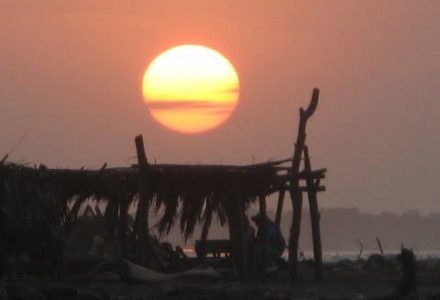
One thought on “Riding the tide through the hidden heart: Mangawhai to Wenderholm (Te Araroa tramp, days 27-30; kms 461-538)”